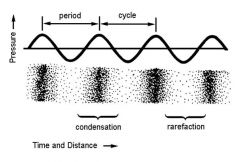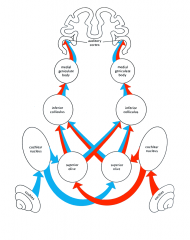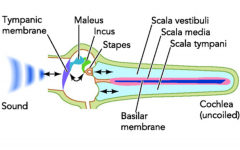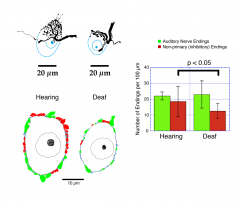![]()
![]()
![]()
Use LEFT and RIGHT arrow keys to navigate between flashcards;
Use UP and DOWN arrow keys to flip the card;
H to show hint;
A reads text to speech;
23 Cards in this Set
- Front
- Back
|
Epidemiology of hearing loss
|
1 in 1500 born death
Last decade of most australian lives will be spent in silence Social isolation (hearing aids arent good enough to understand the task of hearing and understanding) Conitive and language delay |
|
|
Terminology
|

1 cycle per second = 1Hz
amplitude relates to loudness The greater the Fq the higher the perception of pitch. |
|
|
Normal hearing
|
20-20,000Hz
|
|
|
Loudness
|
Loudness is a second component of sound; its perception represents the energy or level of sound pressure. We can hear over a range of 7 orders of magnitude of loudness. This ability requires a system for reducing the brain response to really loud sounds and for amplifying the brain response to really soft sounds
|
|
|
Physical Attributes of Sound
|
1. frequency
2. loudness (energy) 3. timing (onset, duration, change) |
|
|
Ascending Auditory Pathway
|

descending pathway (not shown) modulates what ascends
|
|
|
Eustachian tube and infections
|
In normal adults, fluid caused by inflammation of the middle ear can be drained through the eustachian tube. In children younger than 7-8 years of age, however, the eustachian tube is often the problem. It is horizontal and narrower in children. An infection can cause swelling of the adenoids, lympth tissue, and the swelling can impinge upon the eustachian tube and prevent drainage and/or ventilation. Fluid build up in the middle ear can cause a 30-40 dB hearing loss, where sounds appear muffled, as if the speaker was under water. If the fluid build up is sufficiently bad, the ear drum can rupture and the fluids ooze. This condition is called otitis media with effusion or suppurative otitis media.
|
|
|
Inner Ear Schemmatic
|

4 rows of hair cells
3 outer and 1 inner |
|
|
Type I and Type II ganglion cells
|
1. type I; large IHC
2. type II: small; OHCs 30,000 spiral ganglion cells on each side. 90-95% of these cells are type I and innervate inner hair cells. The remaining 5-10% are type II and innervate outer hair cells. Type I ganglion cells convey information about sound rapidly into the brain; little is known about the function of type II cells. |
|
|
What happens when the ear is exposed to loud noise??
|
Acoustic overexposure: the acoustic overexposure stimulus was an octave band of noise (8-16 kHz) at 100 dB SPL for 2 hours.
|
|
|
Acute Effects of loud noise
|

|
|
|
What really happens after loud noise?
|
there is a delayed loss of spiral ganglion cells. The loss of synapses results in an absence of neurotranmitter and some other trophic factor that causes the auditory nerve fiber to degenerate. This degeneration engulfs the cell body, and eventually the entire neuron dies.
|
|
|
Ratio of nerves to Hair cells
|
Each inner hair cell is innervated by 20-30 type I ganglion cells; each ganglion cell innervates only a single IHC. Do the fibers differ in any way or are they homogeneous? Do they all project into the brain in the same manner?
In contrast, a single type II cell innervates multiple outer hair cells. We know nothing of their response properties. NORMALLY we get HD sound (lots of detail with loss, like pixelation) |
|
|
Does the auditory nerve spontaneously fire?
|
60% of the fibers exhibit high rates of spontaneous activity, up to 100 spikes per second. The other 40% have low rates of spontaneous activity, usually near zero.
THUS 2 different thresholds |
|
|
Arrangement in the Cochlear nucleus, brainstem...
|
Enters v.orderly, layered
Black high spont Red opposite can implant a device directly here to bypass the cochlear nerve |
|
|
Endbulbs
|
found in all vertebrates and the largest synpatic endings
secure synapses, no gitter or delay, links neuroacoustic activity (thus when audio is out of sync in amovie it drives us crazy) |
|
|
Why do we need timing precision? (answer: sound localization, speech comprehension).
|
It is thought that these large synaptic endings ensure that neural activity is tightly coupled to sound. When depolarization invades the endbulb, a small prepotential can be recorded. A half millisecond later, a postsynaptic spike occurs. When the oscilloscope trace is triggered by the prepotential, there is never a failure of the postsynaptic spike. As a result, it has been concluded that this synapse is a high fidelity structure, key to preserving the precise timing of auditory events within CNS activity
|
|
|
Auditory brainstem response
|
Children screened with ABRs (in america screening babies)
Electrodes on the forehead and ear to imit an average response) |
|
|
Deaf cats
|
- auditory nerve synpases changed
- end bulbs atrophy - Reissner's membrane and tectorial membrane collapse |
|
|
inhibitory input to spherical bushy cells
|

DEC. in deafness
- excitatory terminals remain relatively similar - HOWEVER the inhibitory inputs are released and so we think thats why tinnutus starts up |
|
|
Synpase recovery from deafness
|
The normal synapses go back to normal
Thus need to give an implant much earlier, the child becomes normal -after 3 the synapses cant recover Implanted these in cats after puberty and no recovery still |
|
|
HEaring loss and amplification of sound
|
Hearing loss and deafness cause the brain to change. Thus, strategies to repair
hearing cannot simply rely on amplification. |
|
|
Disadvantages of Cochlear implants
|
Hearing aids and cochlear implants can never replace our natural hearing. They
work best in quiet circumstances and are challenged by background noise |

